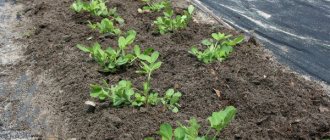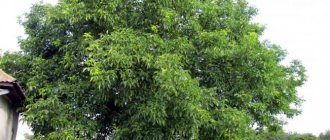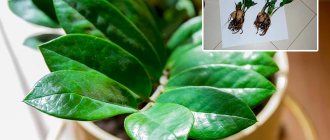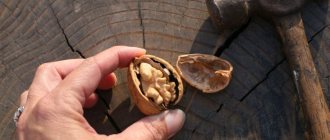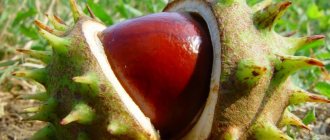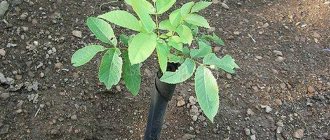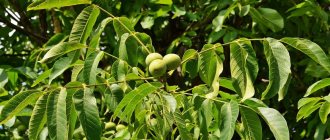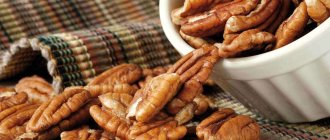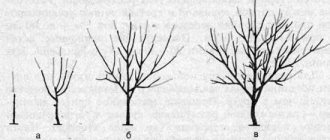Ground Peanut Description
Peanut
– an annual plant of the legume family, up to 60 cm high. The root system of the plant occupies up to 1 meter in diameter, which determines its high resistance to drought.
Peanuts bloom with whitish or yellow-red flowers starting in late June. One flower blooms for only 1 day and then fades. The fruits are oval beans up to 6 cm long. When ripe, they sink into the ground and ripen there.
Structure and development
Peanuts, or groundnuts, are annuals, but in the wild they are perennials. The culture is self-pollinating, grows up to 25-40 cm, some varieties - up to 70 cm.
Brief description of the appearance of the plant:
- shoots erect or creeping;
- leaf blades are pair-pinnate, oval, pointed, up to 11 cm in length, glossy on the outside, pubescent on the inside, located on a thick petiole;
- the flowers are bright yellow, irregular in shape, the lower ones are on stalks, those on top are sessile;
- The root system is branched, tap-type, with a large number of lateral roots.
At the end of June - beginning of July, flowering begins: inflorescences form on the shoots, which are collected in brushes.
The lowest flowers produce fruit. After fertilization, the ovary grows and a gynophore is formed. Peanut beans ripen underground, they are 1-6 cm long, with thick leaves. Each of them contains 2-4 seeds, enclosed in a brown-pink shell. The shell of the kernels has a mesh structure, which is why the crop was called peanuts, which is translated from Greek as “spider”.
Types and varieties of peanuts
Conventionally, all cultivated varieties of peanuts can be divided into 4 groups.
Spanish Group
– small peanuts with a high oil content. The kernels are in a pink-brown shell. This species is used to produce peanut butter, salted and candied nuts.
Valencia Group
– varieties with large kernels. The plants are tall with smooth fruits of 3 seeds each.
Group Runner
– varieties of this group are superior to Spanish varieties in taste and also produce high yields. These peanuts are used to produce peanut butter and salted nuts for beer.
Virginia Group
– large, selected peanuts that are used for confectionery.
Use of peanuts in medicine
It has also found its application in medicine. Amino acids are perfectly absorbed by the body, antioxidants fight free radicals, vitamins and minerals compensate for the lack of these elements.
As a result, well-being improves, the effects of stress are leveled, the nervous system and the functioning of the gastrointestinal tract are normalized, hearing, memory, and attention improve.
Fruits slow down the aging process and prevent the development of cancer. Peanuts give energy and strengthen the immune system. The nut is second only to pomegranate in terms of antioxidant content.
Peanut growing technology
The area for growing peanuts should be well lit, without shading and well ventilated. The soil is light, chernozem or neutral with a high content of potassium, magnesium, and humus. Peanuts do not tolerate soil salinity.
Planting peanuts
produced in warm soil. Seeds germinate at a temperature of 12-14 degrees, 25-30 degrees is considered ideal.
Be sure to wait for settled warm weather; peanuts cannot tolerate frost. Peanuts are usually planted in mid-May, after sowing melons.
The best predecessors of peanuts on the site are cabbage, cucumbers, potatoes
.
Do not plant this crop after legumes.
In the spring, prepare the soil before planting - add nitrophoska 50 g per 1 m2. If you prepare the soil in the fall, you can add humus for digging to a depth of 25-30 cm at the rate of 1-3 kg per m2.
For sowing, seeds can be purchased at the market, only raw peanuts
– not fried or salted.
It is better to clean the seeds before sowing, this will improve germination; choose large seeds. Although you can sow whole beans.
Watering peanuts
carried out in different ways - drip or furrow irrigation. In hot and dry weather, watering is carried out once every 10-15 days, the water should be warm.
Peanuts require high soil moisture
, especially during flowering and bean formation. In September, when it is time to harvest, watering is reduced to allow the seeds to ripen.
Sowing peanuts
on the site it is better to do it in a square nesting method 60x60 or 70x70 cm, 5-6 plants per nest.
There is also a wide-row method of sowing peanuts - between rows 60-70 cm, between plants 15-20 cm and planting depth 6-8 cm.
Peanuts are also sown in a checkerboard pattern with a distance of 25-30 cm between rows, 50 cm between plants and a bean planting depth of 10 cm.
Place 1-3 large seeds in each hole and cover with soil. After planting, water the bed thoroughly using a shower head to avoid washing away the soil.
Video: Growing a crop
Peanuts are a popular crop that is widely used both as an independent product and as part of other products. Although the plant loves subtropical climates, some of its varieties are adapted for cultivation in temperate latitudes. Growing groundnuts is not difficult. But a good harvest can only be achieved if agricultural cultivation techniques are followed.
- Author: petra3578
Rate this article:
- 5
- 4
- 3
- 2
- 1
(5 votes, average: 2.4 out of 5)
Share with your friends!
Growing peanuts in the garden and care
The main care of peanuts during cultivation consists of watering, weeding, hilling, loosening the soil and fertilizing.
to remove weeds on time
, protecting young peanut shoots. While weeding, also loosen the soil.
Peanuts begin to bloom
in June and ends at the end of July. At the end of flowering, the resulting ovaries begin to descend to the ground, where peanuts germinate and then ripen.
At this moment it is necessary to hill up the plants
loose, moist soil (like potatoes). As an option, you can add a layer of mulch made from sawdust, humus, or peat about 5 cm thick. After 10 days, add more soil around the plants.
An average of 30-50 beans ripen under each bush.
Watering peanuts
carried out as the top layer of soil dries. Peanuts need abundant watering during flowering - 1-2 times a week in the morning. After flowering, peanuts need frequent spraying in the evening - once every 2 days or once every 3 days.
During the ripening period, reduce watering to a minimum to allow the beans to ripen. If it rains during this period, it is necessary to cover the bed with polyethylene.
In total, 4-5 waterings of peanuts are carried out during the season.
Peanut feeding
carried out 2 times per season. The first time, when the plants reach a height of 10 cm, add a solution: 20 g of ammonium nitrate, 45 g of potassium salt, 70 g of superphosphate dissolved in 10 liters of water.
Carry out a similar feeding a second time at the beginning of fruit formation.
Video - Growing peanuts at home
Where is it found and cultivated?
In nature, peanuts are found in the subtropics of South America as a perennial. This is due to the warm and humid climate.
As an agricultural annual crop, it is cultivated in the countries of Southeast Asia, tropical Africa and Europe. They also sown fields in North America, displacing cotton.
Where groundnuts grow, there are suitable conditions for its cultivation. It develops without problems on poor soils, but requires a lot of light, warmth up to +20... +27 and moderate humidity.
Peanut diseases and pests
Peanuts are exposed to Alternaria blight, powdery mildew, gray mold, and Fusarium wilt.
.
Powdery mildew
– the appearance of single spots of white plaque on both sides of the leaf, which increase over time and the leaves dry out.
The disease can affect stems and even fruits that set. Plants with severe infection are treated with fungicides - Quadris, Topaz, Ridomil, Switch, Horus.
Alternaria (black leaf spot)
– most often appears at the end of the growing season in humid and warm weather. Black spots form, which grow over time, and leaves die. To prevent the occurrence of the disease, follow the agricultural practices of the species.
Fusarium wilt
– manifestations in the form of root rot, the growth and development of plants stops, the above-ground part becomes yellower, and rapid death occurs.
Follow agricultural practices and harvest crops in a timely manner.
Gray rot
– occurs at the end of peanut flowering. Rusty-brown spots appear, from the leaves they move to the petioles, then to the stems. The plant withers and dies. The fruits that have already formed become deformed. The disease manifests itself during humid and warm weather at the end of summer.
Pests
capable of harming peanuts -
aphids, thrips, caterpillars
. If you find aphids and caterpillars in the area, you need to sprinkle the bed with a mixture of tobacco dust and wood ash.
To combat thrips, use insectoacaricidal preparations.
Wireworms cause the most damage
, whose larvae live in the ground. They easily crack bean shells and feed on peanut seeds.
To destroy wireworms, pit traps are set in the ground. Pieces of carrots, beets, and potatoes are placed in such traps, covered with a board or a piece of slate, and after a while the wireworm larvae that have crawled down to feast on the vegetables are opened and destroyed.
To prevent the appearance of pests and diseases in the beds with peanuts, always follow the agricultural practices of the species and crop rotation, and remove weeds from the beds in a timely manner.
How culture grows
Peanuts are the only nut that does not grow on a tree. The herbaceous plant is classified as an annual. It is a bush up to 40 cm high, in rare cases up to 70-100 cm. The plant has pinnate leaves, and during the flowering period small yellow flowers appear. After flowering, when the flowers die, peanut fruits gradually form in the ground.
Flowers live for one day, and during this short time they need to be pollinated. The process of self-pollination is complex. Due to the lack of abundant flowering, ovaries are not always formed. Many flowers die without being pollinated.
The peculiarity of the vegetative development of the plant is that up to 200 flowers can form during the growth period. But this is enough for up to 40 beans to form in the ground on one bush. Fruits are formed, covered with a dense shell. The peanuts themselves do not grow in the root system, like potatoes, but on separate tendrils.
Each tendril is a fertilized peduncle with an ovary. It gradually lengthens at the end and then penetrates the soil on its own. However, once the tendrils reach the ground, it is better to cover the shrub with loose soil, helping them penetrate the ground. From each ovary in the ground, a seed grows parallel to the surface.
The annual crop can grow in unpretentious conditions: under the hot sun and with a lack of moisture. It can easily obtain nutrition from the soil and even enrich it with nitrogen. To do this, the bush forms a long tap root. It can reach a length of 1.5 m.
In appearance, the grass is a strongly branching shrub, which, during the period of growth and formation of fruits, throws out more and more tendrils. Above the surface of the earth you can watch how the crop grows. Pods with seeds can be found underground only by digging up a bush.
Important to remember! Depending on weather conditions and the variety, it may take 4-5 months from planting the crop to harvesting. The fruits ripen closer to autumn. But they need to be collected with its onset.
Main types
There are 4 groups of peanut varieties. Each of them combines varieties with similar characteristics:
- Virginia. The peanut variety has selected large nuts with excellent taste. The pods are located shallow underground, at a distance of approximately 7 cm from the surface. Shrubs reach a height of 55 cm.
- Valencia (Redksin). The variety consists of tall shoots of a reddish hue up to 1 m in height. Large nut kernels are covered with a reddish skin. Each pod can contain 3 nuts.
- Spanish. The nuts of this variety are medium in size, but they have a high oil content. Shrubs have average yield. Most often they are sold in stores fried in packages with added salt.
- Runner. This variety of groundnut is widely grown for sale as roasted or raw and for making oil. The bushes have a high yield, and the nuts have an excellent taste.
In addition to being used in the food and cosmetics industries, legumes are often used to enrich the soil with nitrogen. This occurs due to the symbiosis between nodule bacteria and the plant itself. How much nitrogen the bacteria release into the soil depends on its composition, the type of crop being planted, and in what conditions it will grow.
Harvesting and storing peanuts
After the leaves on the plants turn yellow, dig up a couple of beans and if the seeds are easy to get, it's time to harvest.
By the time of harvest, the temperature remains stable around +10 degrees. But you can’t delay harvesting either; when it gets cold, peanuts become bitter and become unsuitable for food.
Peanut harvesting
made with a pitchfork, digging up bushes. The beans are separated from the stems and dried in the shade in the fresh air.
After drying, the beans are placed in a fabric bag and stored in a dry room with ventilation and a temperature not exceeding 10 degrees.
Seed preparation
700 varieties of peanuts are cultivated in South and North America. The following varieties are zoned for the conditions of the Russian climate: Bayan, Krasnodarets, Stepnyak.
Proper preparation for planting seed guarantees success. Unroasted peanuts are used, the seeds are pre-hardened. This is done in late April early May.
Beans disinfected in a weak solution of potassium permanganate are kept for three days in the daytime at +2... +3 degrees, and at room temperature at night.
They are sprouted in a wet cloth, and when sprouts appear, they are planted in peat pots. Two-week-old seedlings are ready to be transferred to a permanent location.
Beneficial properties and harm of peanuts
Peanuts are very healthy
. The composition includes linoleic, pantothenic, folic acids, vegetable fats, easily digestible proteins, glutenins, starch, vitamins and macroelements. The antioxidants in peanuts make them an effective means of preventing cardiovascular diseases.
Squirrels
are perfectly absorbed by the human body due to the optimal ratio of amino acids.
Folic acid
promotes the renewal of body cells, and
fats
have a slight choleretic effect.
For people with increased excitability, peanuts have a calming effect, help restore strength, improve memory, increase potency, and eliminate insomnia.
A large amount of protein increases the feeling of fullness. Peanuts do not contain cholesterol.
Peanut harm
Even such a product cannot be used in unlimited quantities, especially for those who are overweight.
When peanuts are consumed with the skin containing strong allergens, people prone to allergies suffer.
Moldy peanuts
may lead to poisoning.
Where do peanuts grow?
Peanuts love warmth, and for the beans hidden under the soil to ripen, they need a long, dry summer and the same autumn. It takes 120–160 days from planting beans to harvesting. Such conditions do not exist everywhere.
South America is considered the original habitat and birthplace of culture. When the mainland was discovered by Europeans, many interesting plants were sent to the mother country and other Spanish, Portuguese and British colonies. The Spaniards were the first to try unusual beans, finding them tasty and very useful on long voyages. In the Old World, peanuts were also popular. As an exotic additive to dishes and a semblance of cocoa beans, it began to be used in cooking.
To satisfy the growing demand, the conquerors of the American continent had little use for the rare and unstable supply of beans from new lands. Therefore, the Portuguese, who assessed the nutritional properties and productivity of groundnuts, became interested in how peanuts grow in African conditions.
Peanuts in Africa
European colonies on the dark continent supplied wood, spices, minerals, cotton and slaves to the metropolis. However, due to poor lands, it was very difficult to develop agriculture here. Peanuts helped solve this important problem.
Not only did it provide the beans desired by Europeans, but it also fed the local population as well as livestock. In some countries, culture has become the main source of income.
Although a lot of time has passed since the conquest of America and the appearance of groundnuts in Africa, no one is still surprised why Senegal is called the peanut republic. Since the 17th century, first Portuguese and then French landowners here actively plowed free lands for peanuts. In the last century, growing more than a million tons of beans a year, the country has become the world's largest supplier of groundnuts.
Peanut in Asia
Due to the rich composition of peanuts and the presence of valuable vegetable oil in them, used as food for technical purposes, the culture is recognized in other parts of the world.
Huge plantations of this type of legume are located in Asia. Since the 16th century, the plant has been known in India; a little later, crops appeared in the Philippines, Macau and China. It was the Celestial Empire that took the palm from Senegal, where the vast majority of the country’s residents still work in cultivation, planting and harvesting.
American Peanut Success Story
Since the 19th century, groundnut or peanut plantations have appeared on the North American continent. The troops of the opposing sides, who had difficulties with food during the Civil War, were able to maintain their strength thanks to peanuts.
But when the war ended, this legume crop was considered unprofitable due to manual cultivation, and the beans themselves were classified as food for the poor.
Only a happy course of circumstances allowed peanuts in the USA to return to the podium they deserved. The cotton plant, which most farmers grew at the turn of the century, sucked all the juices out of the soil. The number of arable lands was declining, farmers were plagued by crop failures and pest attacks. There was an urgent need to take active measures to switch to other crops and maintain agriculture.
The famous US scientist D.V. Carver, having studied how much protein, oils, amino acids and other compounds beneficial for the human body are in peanuts, was inspired by the idea of popularizing this interesting crop. According to the agrochemist, it was impossible to refuse a plant whose beans consist of 50% oil and a third of valuable, easily digestible protein. Therefore, thanks to the development of hundreds of food and technical products based on beans, automation of cultivation and gentle influence on the soil, peanuts from the USA have become a cult plant.
The lion's share of the local bean harvest is used to make peanut butter, which Americans love, industrial and edible oil, as well as to feed livestock, make soap and other needs.
Where do peanuts grow in Russia?
Today, interest in the plant continues unabated. During the USSR, no attention was paid to peanuts, and experience in its cultivation was undertaken only in the southern republics. Where do peanuts grow in Russia? There are no large plantations of this type of legume in the country, but enthusiasts in the southern regions, the Black Earth Region, the Southern Urals and even the middle zone are making successful attempts to harvest beans in their summer cottages and garden plots.
Even those who, due to climatic conditions, cannot treat themselves to peanuts from the garden should not give up this crop. Original peanut bushes are easy to grow in an indoor pot.
A video about how peanuts grow will help you learn more about the agricultural technology of the crop, understand its characteristics and needs:
Nut processing methods
Of course, nuts can be eaten raw, after peeling them, but after processing their taste improves significantly.
Roasting nuts not only improves the taste (intensifies their nutty flavor and adds a sweetish note), but also activates antioxidants and eliminates aflatoxin. Roasted chopped peanuts are added to salads and desserts.
Don't know how to fry nuts bought at the market in their shells? It's very easy to do. Simply pour the product onto a baking sheet and place in the oven (heat to 75 degrees) for 15-20 minutes. That's the whole secret of the most popular cooking method.
Boiled kernels have a unique taste and aroma. Boiling water also enhances their nutritional and antioxidant abilities.
Peanut butter is a paste made from crushed ground nuts with or without added oil. This product, like peanut milk, is popular all over the world.
In South India and Sri Lanka it is popular in the form of "chutney" - a paste made from nuts, coriander leaves, chili peppers, garlic, salt and mustard seeds [6][7].
Peanuts for weight loss
Scientists have carefully studied how peanuts affect weight. The first conclusion of scientists: despite the impressive calorie content and fat content, this product does not cause obesity under normal conditions. Moreover, it can prevent the accumulation of extra pounds.
The researchers conducted an experiment with a group of women. For 6 months, they consumed peanuts instead of their usual sources of fat. The result is minus 3 kilograms of weight.
In another experiment, 89 g of peanuts (approximately 500 kcal) were added daily to the normal diet for 8 weeks. At the end of the experiment, the experiment participants were weighed. There was no weight gain as expected.
Another experiment was conducted by scientists in Spain. After 28 months, those who ate any form of peanut at least twice a week were 31 percent less likely to gain weight.
Peanuts, being rich in proteins, quickly satisfy the feeling of hunger. In addition, it is a source of insoluble dietary fiber, which promotes weight loss.
But it’s worth remembering: salted peanuts retain excess moisture in the body, and this means extra pounds. Also, do not forget how many calories are contained in 100 g of this product. After all, consuming too large portions of nuts can cause the opposite effect and, on the contrary, increase weight [8].
